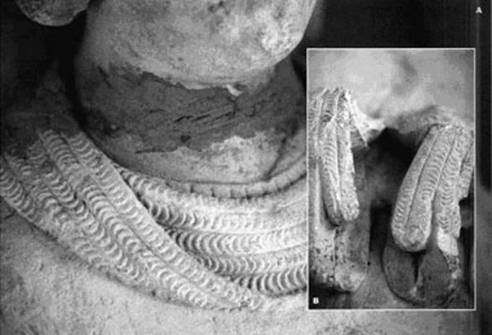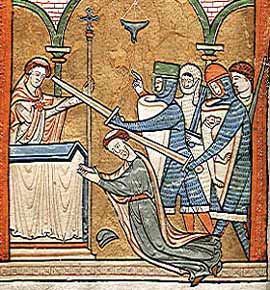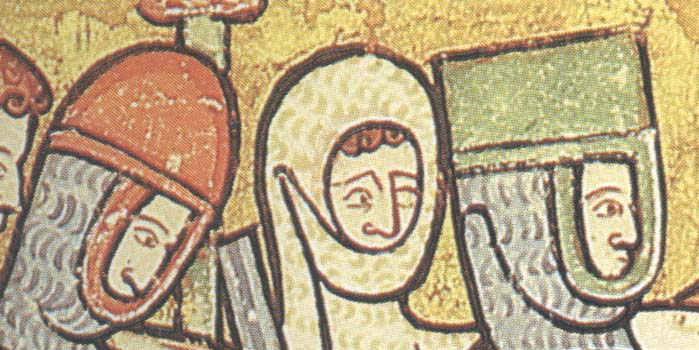| Author |
Message |
|
Pete Vanderzwet
|
 Posted: Tue 10 Apr, 2007 8:05 pm Post subject: When was this used? Posted: Tue 10 Apr, 2007 8:05 pm Post subject: When was this used? |
 |
|
I'm wondering about the historical timeframe of the helm linked to below. I've seen it used in various sources but I can't personally find information on exactly when it was used.

I know I'm posting this in the "historical arms" section, so my apologies if I have posted to the wrong forum. I figured you guys would know something about this.
|
|
   |
 |
Jared Smith

|
 Posted: Tue 10 Apr, 2007 8:33 pm Post subject: Posted: Tue 10 Apr, 2007 8:33 pm Post subject: |
 |
|
Not to be to bad... but that one does not look like it was ever used!
The conic form of arming cap worn under a mail coif was seen during the 13th century, possibly earlier. An effigy at Tickenham, Somerset England depicts a knight wearing just such a device. One of the Osprey books has the image showing the appearance of the coif. The effigy is quite detailed, so there is not much mistaking it.
 Attachment: 24.94 KB Attachment: 24.94 KB

Absence of evidence is not necessarily evidence of absence!
|
|
  |
 |
|
Pete Vanderzwet
|
 Posted: Tue 10 Apr, 2007 11:30 pm Post subject: Posted: Tue 10 Apr, 2007 11:30 pm Post subject: |
 |
|
Was it never worn over the coif as a helm itself? I realise the above picture I posted isn't the most authentic, but I think you know what I'm getting at 
Like I said, I've seen it worn in a variety of sources but I can't pin down its usage historically.
|
|
   |
 |
Jean Thibodeau

|
 Posted: Tue 10 Apr, 2007 11:44 pm Post subject: Posted: Tue 10 Apr, 2007 11:44 pm Post subject: |
 |
|
| Pete Vanderzwet wrote: | Was it never worn over the coif as a helm itself? I realise the above picture I posted isn't the most authentic, but I think you know what I'm getting at 
Like I said, I've seen it worn in a variety of sources but I can't pin down its usage historically. |
Could be an arming cap but it looks way to large for that ?
An arming cap like this could have been worn under a maille coif or over the coif and maybe by itself.
But large in size like in the picture it looks like a huge kettle hat but I've never seen anything " real " like it before.
What is the source of the picture ? It looks like a computer game thing to me ?
You can easily give up your freedom. You have to fight hard to get it back!
|
|
  |
 |
Randall Moffett

|
 Posted: Wed 11 Apr, 2007 12:15 am Post subject: Posted: Wed 11 Apr, 2007 12:15 am Post subject: |
 |
|
They had helmets worn over coids of that nature but I agree that one is very, very large. If the model head is close to an average human's head that is a big helmet. You can find many pictures around 1200-1300 in germans with that ty[pe of helmet, though they fit closer.
RPM
|
|
  |
 |
Robin Smith

|
 Posted: Wed 11 Apr, 2007 1:09 am Post subject: Posted: Wed 11 Apr, 2007 1:09 am Post subject: |
 |
|
I'm gonna jump to Pete's defense here. Those model heads are decievingly small. I have seen them used to model other helmets, and they always make the helmets look gianormus. As for the flat-topped cyclindrical, that would be 12th C. Helmets like this would soon have a faceplate and become the "totenkopf" (sp?) There is an illumination in the Martyrdom of St. Thomas a Becket that shows this type of helm.
A furore Normannorum libera nos, Domine
|
|
   |
 |
Bruno Giordan

|
 Posted: Wed 11 Apr, 2007 5:03 am Post subject: Posted: Wed 11 Apr, 2007 5:03 am Post subject: |
 |
|
I like the chinstrap, it is like the one I adopted for my norman.
Design derived from sword belts, however, I think that it might have existed but after having tried it I found that it is not very practical.
As of this helm, it is strange the rpesence of the ousideleather ring.
For me that\'s the really wrong part of this helm.
Correct me if I\'m wrong, it has no apparent purpose being outside but to be cut by enemy\'s blows.
|
|
  |
 |
Chad Arnow
myArmoury Team


|
 Posted: Wed 11 Apr, 2007 5:44 am Post subject: Posted: Wed 11 Apr, 2007 5:44 am Post subject: |
 |
|
The angle of the pic makes it hard to tell all the angles, but between conical Norman helms and early great helms we do see flat-topped helms that taper out as they go up. This one seems to do that a little bit. That would put a hem like this somewhere around the last quarter of the 12th century.

ChadA
http://chadarnow.com/
|
|
    |
 |
|
Pete Vanderzwet
|
 Posted: Wed 11 Apr, 2007 6:48 am Post subject: Posted: Wed 11 Apr, 2007 6:48 am Post subject: |
 |
|
Also consider the model is not wearing a padded arming cap w/ coif.
I'm not concerned with the example in the picture so much as their usage historically. They seem to be used all over the place.
Robin, were you talking about this?

I can't tell if there is a nose guard there or if its part of his coif. I have no information on this manuscript other than the website author's claim that it is 12th century.
Perhaps this is a better example from Manning Imperial:

There they label it as 13th -14th century.
Randall,
Could I bother you to post some?
|
|
   |
 |
Chad Arnow
myArmoury Team


|
 Posted: Wed 11 Apr, 2007 6:59 am Post subject: Posted: Wed 11 Apr, 2007 6:59 am Post subject: |
 |
|
| Pete Vanderzwet wrote: | Robin, were you talking about this?
I can't tell if there is a nose guard there or if its part of his coif. I have no information on this manuscript other than the website author's claim that it is 12th century.
|
That's a face guard. It's colored the same as the helm, not the coif. That is a slightly more developed/later version of what you posted.
A late 12th century date is pretty appropriate for that image.

ChadA
http://chadarnow.com/
|
|
    |
 |
Robin Smith

|
 Posted: Wed 11 Apr, 2007 7:06 am Post subject: Posted: Wed 11 Apr, 2007 7:06 am Post subject: |
 |
|
| Chad Arnow wrote: | | Pete Vanderzwet wrote: | Robin, were you talking about this?
I can't tell if there is a nose guard there or if its part of his coif. I have no information on this manuscript other than the website author's claim that it is 12th century.
|
That's a face guard. It's colored the same as the helm, not the coif. That is a slightly more developed/later version of what you posted.
A late 12th century date is pretty appropriate for that image. |
You think so? Notice the red nasal has one too. Still, it is clearly the same type of helm...
A furore Normannorum libera nos, Domine
|
|
   |
 |
Chad Arnow
myArmoury Team


|
 Posted: Wed 11 Apr, 2007 7:23 am Post subject: Posted: Wed 11 Apr, 2007 7:23 am Post subject: |
 |
|
| Robin Smith wrote: | | You think so? Notice the red nasal has one too. Still, it is clearly the same type of helm... |
What are you asking about? The red nasal has one of what?
Both helms have face protection of some kind and I believe they're attached to the helm because they are colored the same. Both are worn over coifs, though.
According to books I've read on the subject fairly recently, facial protection was reintroduced after the development of the flat-topped helms.

ChadA
http://chadarnow.com/
|
|
    |
 |
Robin Smith

|
 Posted: Wed 11 Apr, 2007 7:33 am Post subject: Posted: Wed 11 Apr, 2007 7:33 am Post subject: |
 |
|
The facial peice. Its so hard to make judgments on armour design from an illumination.... I'm not convinced that its not some artistic depiction of leather lining on the edge of the coif...
A furore Normannorum libera nos, Domine
|
|
   |
 |
|
Pete Vanderzwet
|
 Posted: Wed 11 Apr, 2007 7:36 am Post subject: Posted: Wed 11 Apr, 2007 7:36 am Post subject: |
 |
|
[quote="I'm not convinced that its not some artistic depiction of leather lining on the edge of the coif...[/quote]
Thats what it looks like to me too, since its on both sides of the face.
|
|
   |
 |
Chad Arnow
myArmoury Team


|
 Posted: Wed 11 Apr, 2007 12:26 pm Post subject: Posted: Wed 11 Apr, 2007 12:26 pm Post subject: |
 |
|
| Robin Smith wrote: | | The facial peice. Its so hard to make judgments on armour design from an illumination.... I'm not convinced that its not some artistic depiction of leather lining on the edge of the coif... |
Well, authors more published and intelligent than me have used that very illumination as evidence of early facial protection. 

ChadA
http://chadarnow.com/
|
|
    |
 |
Bruno Giordan

|
 Posted: Wed 11 Apr, 2007 2:01 pm Post subject: Posted: Wed 11 Apr, 2007 2:01 pm Post subject: |
 |
|
| Chad Arnow wrote: | | Robin Smith wrote: | | The facial peice. Its so hard to make judgments on armour design from an illumination.... I'm not convinced that its not some artistic depiction of leather lining on the edge of the coif... |
Well, authors more published and intelligent than me have used that very illumination as evidence of early facial protection.  |
As for the image we ar discussing, and solely concerning hat, I do not concur, since the colored brim leaves uncoverd exctly the same part of face as it does a coif.
Facial masks did cover more, even when they were partial.
But we are just talking about a possible blunder by the artist, other contemporary art (there is a famous seal at Louvre) shows well what a facial mask could be like.
|
|
  |
 |
Chad Arnow
myArmoury Team


|
 Posted: Wed 11 Apr, 2007 2:28 pm Post subject: Posted: Wed 11 Apr, 2007 2:28 pm Post subject: |
 |
|
| Bruno Giordan wrote: | As for the image we ar discussing, and solely concerning hat, I do not concur, since the colored brim leaves uncoverd exctly the same part of face as it does a coif.
Facial masks did cover more, even when they were partial.
But we are just talking about a possible blunder by the artist, other contemporary art (there is a famous seal at Louvre) shows well what a facial mask could be like. |
Part of the face encircling ring on both figures seems to be seamless with the helm, though there is a seam at the outside.
I agree they don't look like any other face masks I've seen, though. I could be wrong about them, but the lack of a seam in one place is baffling.
See below.
 Attachment: 76.66 KB Attachment: 76.66 KB


ChadA
http://chadarnow.com/
|
|
    |
 |
|
Pete Vanderzwet
|
 Posted: Wed 11 Apr, 2007 3:15 pm Post subject: Posted: Wed 11 Apr, 2007 3:15 pm Post subject: |
 |
|
|
Could they be chinstraps?
|
|
   |
 |
Chad Arnow
myArmoury Team


|
 Posted: Wed 11 Apr, 2007 3:40 pm Post subject: Posted: Wed 11 Apr, 2007 3:40 pm Post subject: |
 |
|
| Pete Vanderzwet wrote: | | Could they be chinstraps? |
Their chins are cleary below those colored bands, so I'd guess they weren't chinstraps.

ChadA
http://chadarnow.com/
|
|
    |
 |
Jean Thibodeau

|
 Posted: Thu 12 Apr, 2007 8:38 am Post subject: Posted: Thu 12 Apr, 2007 8:38 am Post subject: |
 |
|
| Chad Arnow wrote: | | Pete Vanderzwet wrote: | | Could they be chinstraps? |
Their chins are clearly below those colored bands, so I'd guess they weren't chinstraps. |
Very difficult to be 100% sure what the intent of the artist was when there is a certain " primitive " sense of perspective involved ?
The loop could be a wide band framing the face: A bit like a face mask leaving the eyes and nose uncovered and acting a bit like protective cheek pieces that are formed into one unit.
Alternatively, there could be a central nasal and seen from the front one might see a UU shape instead of one large U shape.
The part of the loop framing the nose side of the painting/drawing could be either the other side of a face framing plate or the central nasal. I'm just looking at it from memory of how I would draw when I was a kid before I mastered perspective drawing:
There is some similarities between children's drawings and period drawing in the way they deal with difficulty with a 3/4 profile drawing: Full profile or full frontal elements get mushed together in ambiguous ways.
Just a credible alternate interpretation/theory and I 'm not saying that this is in any way certain.
You can easily give up your freedom. You have to fight hard to get it back!
|
|
  |
 |
|
|

